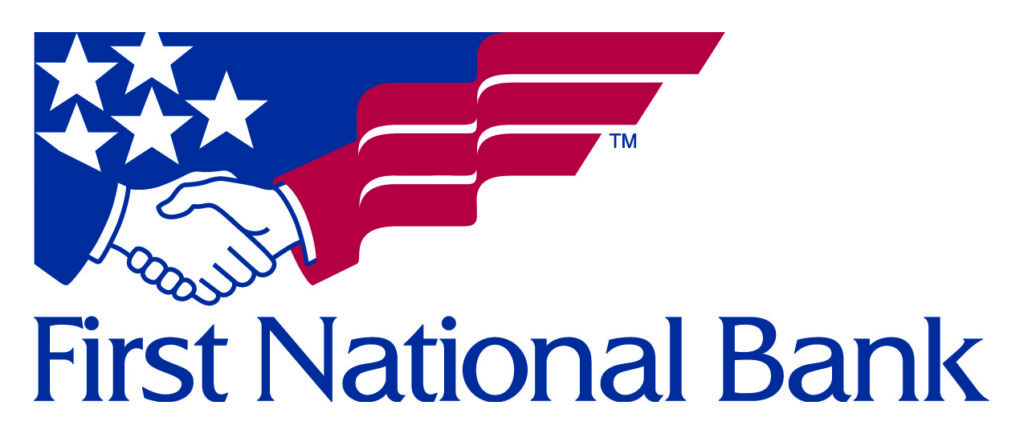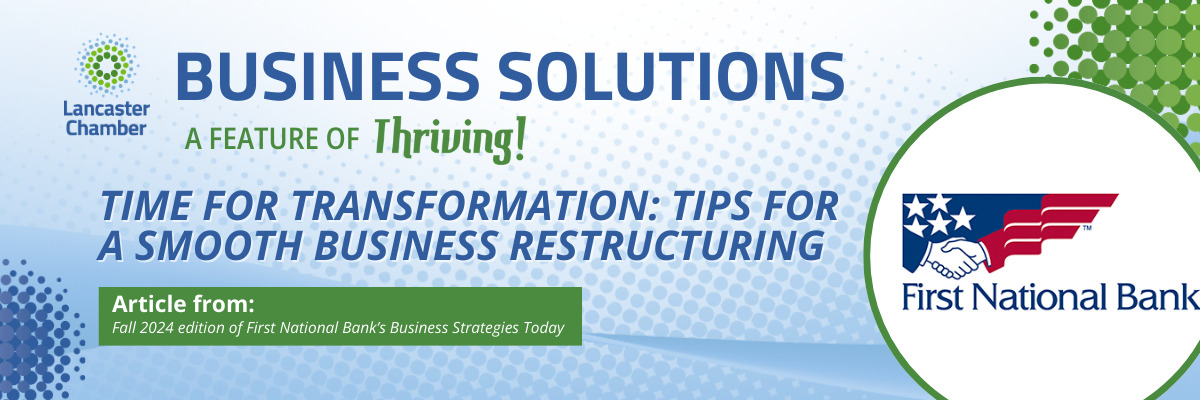A Business Solutions feature piece from our Spring 2025 issue of the Lancaster Thriving Publication.
The following article originally appeared in the Fall 2024 edition of First National Bank’s Business Strategies Today (fnb-online.com/bst).
The majority of businesses in the U.S. are sole proprietorships or small businesses with few employees, but growth often demands a new organizational and/or entity structure. Such upheaval can be complex but advantageous — possibly offering the business new legal and liability protections, tax benefits and avenues for financing.
Before, during and after a restructuring, business owners must take care to properly adapt to new circumstances, thereby creating a smooth transition for themselves and any new stakeholders.
Entity Options
Beyond growth, companies restructure for a variety of reasons, including taking on new partners or changing ownership, mitigating financial crises, shifting business goals and adapting to market changes. An additional motivation is reducing personal liability for the business’ debts and obligations.
- Sole Proprietorships: The easiest type of business to start, featuring one individual who is the lone owner of a business, although they can hire employees. Profits are taxed as personal income, and self-employment taxes are owed. There is no legal separation between business and personal liability.
- Partnerships: A good fit for small businesses with more than one owner or for professional practices, such as law firms. There are two common types: limited partnerships (LPs) and limited liability partnerships (LLPs). LPs have just one partner with unlimited liability, while others have limited liability and control. In LLPs, all partners have limited liability.
- Limited Liability Companies (LLCs): A blend of corporation and partnership structures, ideal for smaller companies that experience higher levels of risk. LLCs protect owners — referred to as Members in an LLC — from personal liability in most cases and, generally, are taxed at a lower rate than corporations. Profits and losses can be passed through to personal income.
- Corporations: More complex entities that provide strong personal liability protection and exist separate from their owners. It can be easier for corporations to raise capital or weather transitions in ownership, but they also pay higher tax rates and require extensive reporting.
Restructuring with Care
Upon making the decision to restructure, it is a best practice for an owner to perform a business review, examining processes, infrastructure, objectives and more. There should also be a thorough insurance and risk management review — both to assess current coverage and, more importantly, to anticipate additional or different coverage that may be beneficial under the new entity structure. If a change in entity is accompanied by a change in ownership, policies likely will need to be canceled and replaced under the new owners and legal structure.
- Buy-Sell Agreements: Contracts that protect business transition plans if a principal retires, dies or becomes incapacitated. This is strongly recommended upon taking on new business partners, as the agreements preserve the interests of remaining partners and the principal’s family or successors. Funding for these agreements can include life insurance policies.
- Directors and Officers (D&O) Insurance: Coverage that protects those who can be sued as a result of holding a leadership role with a business, nonprofit or private corporation. Amid a reorganization in which a company’s management, controlling partners and/or entity changes, such policies can ensure protection from lawsuits or claims if there are any coverage gaps.
- Tail Coverage: When a business is restructured and a new legal entity is created, it is important to consider how best to insulate the new entity from unknown liabilities of the former entity. This can be accomplished by utilizing the Extended Reporting Period of the former policy or by purchasing a tail coverage policy for the former entity (generally, for a one-year, three-year or longer period). These policies can be important to address previous professional liability exposures, such as medical malpractice.
- Representation and Warranties Insurance: Highly specialized and primarily used in very large transactions — deals of $50 million or more, for example — these policies protect against any losses stemming from unintentional and unknown breaches of the seller’s representations made during a merger or acquisition. This coverage provides a backstop for previously negotiated indemnity — or can replace required indemnification protections altogether — and offers a smoother exit for the seller. For buyers, there is a higher likelihood to succeed on a potential claim than if no policy exists, as a seller has less reason to contest.
Enjoying a New Era
Restructuring can provide new life to a business — and new challenges. Professional advisors are valuable for guiding a transition, including attorneys and financial experts who can work with insurance agents to determine the safest way to reorganize.
Check out fnb-online.com/business for products and services that support businesses in transition.
FNB BIO
First National Bank (FNB), one of Pennsylvania’s leading full-service banks, has been committed to residents and businesses in its regions for more than 160 years. Through a network of hundreds of convenient branch locations, FNB provides customers with traditional banking services, commercial banking, wealth management, insurance, private banking and other innovative services like a comprehensive suite of online and mobile banking tools. These financial solutions are delivered by local employees with local decision making and personal service. Visit an FNB branch near you or visit us online at www.fnb-online.com. Equal Housing Lender, Member FDIC.

not secure

